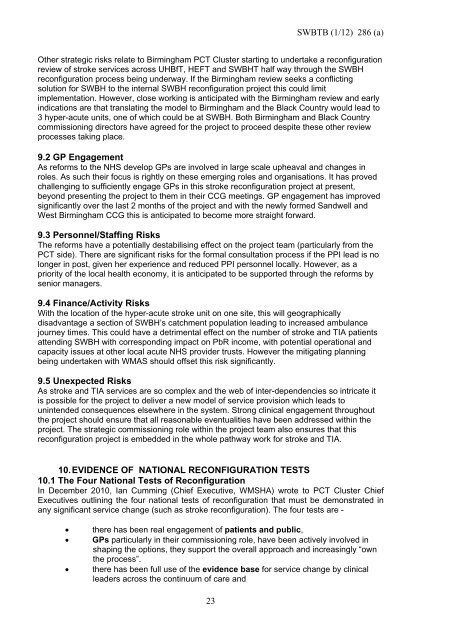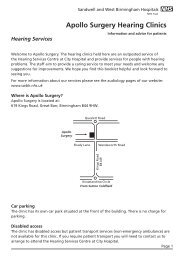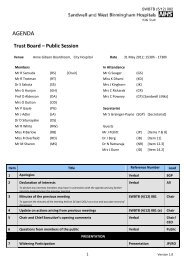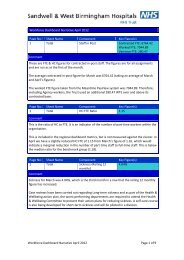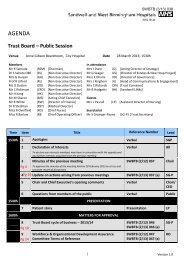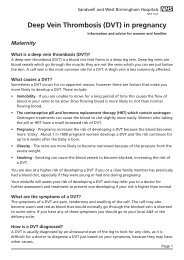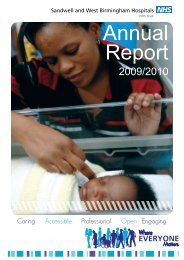January 2012 - Sandwell & West Birmingham Hospitals
January 2012 - Sandwell & West Birmingham Hospitals
January 2012 - Sandwell & West Birmingham Hospitals
Create successful ePaper yourself
Turn your PDF publications into a flip-book with our unique Google optimized e-Paper software.
SWBTB (1/12) 286 (a)<br />
Other strategic risks relate to <strong>Birmingham</strong> PCT Cluster starting to undertake a reconfiguration<br />
review of stroke services across UHBfT, HEFT and SWBHT half way through the SWBH<br />
reconfiguration process being underway. If the <strong>Birmingham</strong> review seeks a conflicting<br />
solution for SWBH to the internal SWBH reconfiguration project this could limit<br />
implementation. However, close working is anticipated with the <strong>Birmingham</strong> review and early<br />
indications are that translating the model to <strong>Birmingham</strong> and the Black Country would lead to<br />
3 hyper-acute units, one of which could be at SWBH. Both <strong>Birmingham</strong> and Black Country<br />
commissioning directors have agreed for the project to proceed despite these other review<br />
processes taking place.<br />
9.2 GP Engagement<br />
As reforms to the NHS develop GPs are involved in large scale upheaval and changes in<br />
roles. As such their focus is rightly on these emerging roles and organisations. It has proved<br />
challenging to sufficiently engage GPs in this stroke reconfiguration project at present,<br />
beyond presenting the project to them in their CCG meetings. GP engagement has improved<br />
significantly over the last 2 months of the project and with the newly formed <strong>Sandwell</strong> and<br />
<strong>West</strong> <strong>Birmingham</strong> CCG this is anticipated to become more straight forward.<br />
9.3 Personnel/Staffing Risks<br />
The reforms have a potentially destabilising effect on the project team (particularly from the<br />
PCT side). There are significant risks for the formal consultation process if the PPI lead is no<br />
longer in post, given her experience and reduced PPI personnel locally. However, as a<br />
priority of the local health economy, it is anticipated to be supported through the reforms by<br />
senior managers.<br />
9.4 Finance/Activity Risks<br />
With the location of the hyper-acute stroke unit on one site, this will geographically<br />
disadvantage a section of SWBH’s catchment population leading to increased ambulance<br />
journey times. This could have a detrimental effect on the number of stroke and TIA patients<br />
attending SWBH with corresponding impact on PbR income, with potential operational and<br />
capacity issues at other local acute NHS provider trusts. However the mitigating planning<br />
being undertaken with WMAS should offset this risk significantly.<br />
9.5 Unexpected Risks<br />
As stroke and TIA services are so complex and the web of inter-dependencies so intricate it<br />
is possible for the project to deliver a new model of service provision which leads to<br />
unintended consequences elsewhere in the system. Strong clinical engagement throughout<br />
the project should ensure that all reasonable eventualities have been addressed within the<br />
project. The strategic commissioning role within the project team also ensures that this<br />
reconfiguration project is embedded in the whole pathway work for stroke and TIA.<br />
10. EVIDENCE OF NATIONAL RECONFIGURATION TESTS<br />
10.1 The Four National Tests of Reconfiguration<br />
In December 2010, Ian Cumming (Chief Executive, WMSHA) wrote to PCT Cluster Chief<br />
Executives outlining the four national tests of reconfiguration that must be demonstrated in<br />
any significant service change (such as stroke reconfiguration). The four tests are -<br />
<br />
<br />
<br />
there has been real engagement of patients and public,<br />
GPs particularly in their commissioning role, have been actively involved in<br />
shaping the options, they support the overall approach and increasingly “own<br />
the process”.<br />
there has been full use of the evidence base for service change by clinical<br />
leaders across the continuum of care and<br />
23


